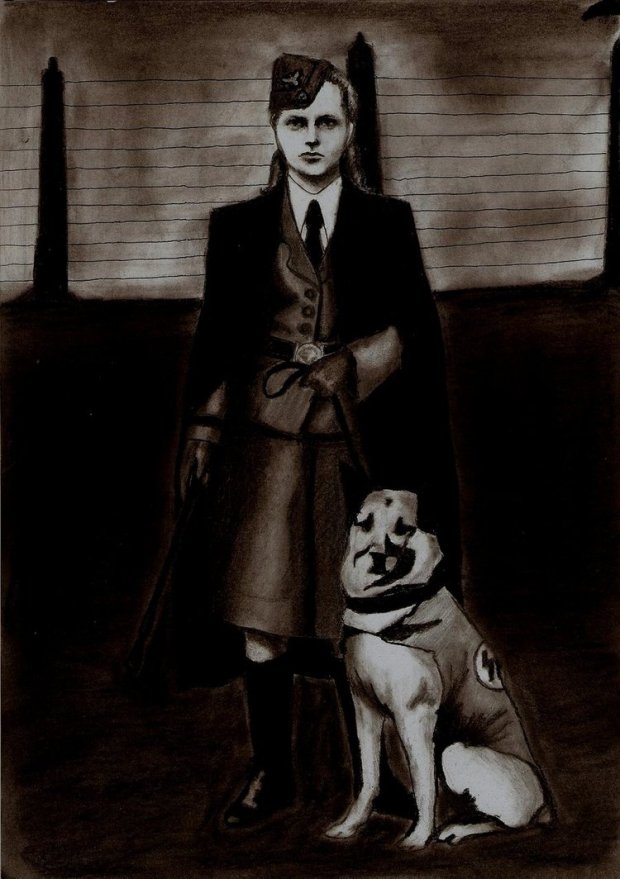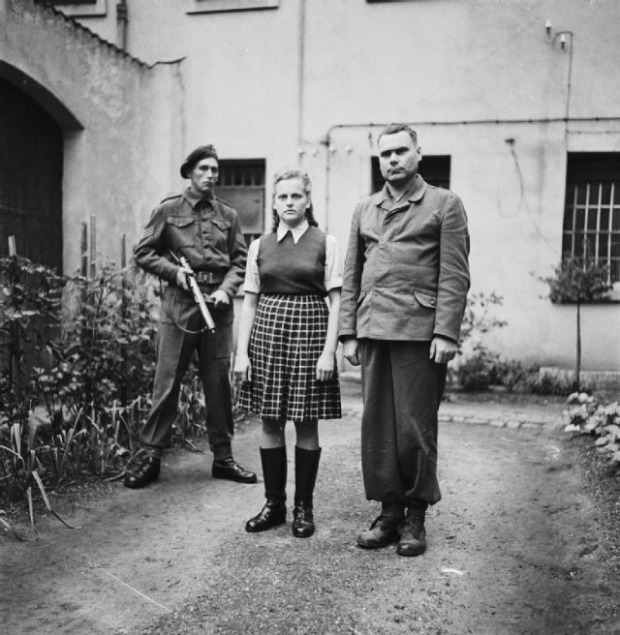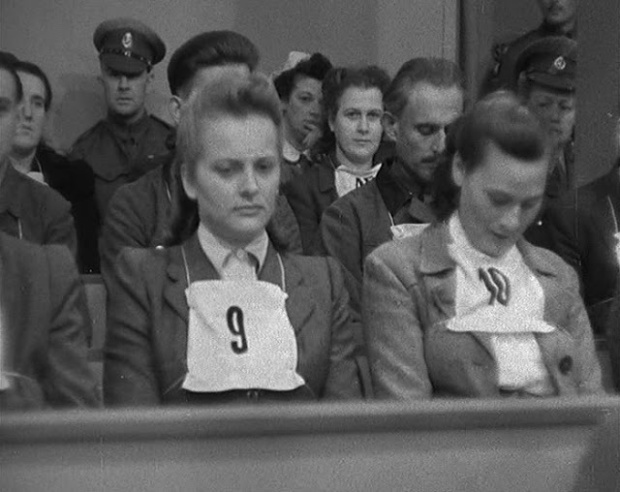
Men don’t have the monopoly on doing evil acts, throughout history there have been many women who acted in barbaric ways. Often their acts would be more evil then that of their male counterparts as was the case with Irma Grese, the proof that evil is not bound to gender but personality.
Irma Ida Ilse Grese (7 October 1923 – 13 December 1945) was a female SS guard at the Nazi concentration camps of Ravensbrück and Auschwitz, and served as warden of the women’s section of Bergen-Belsen.
Grese was convicted for crimes against humanity committed at Auschwitz and Bergen-Belsen, and sentenced to death at the Belsen trial. Executed at 22 years of age, Grese was the youngest woman to die judicially under British law in the 20th century. She was nicknamed by the camps’ inmates “the Hyena of Auschwitz”
During World War II Irma Grese was the most notorious of the female Nazi war criminals. She was born on October 7, 1923, to a agricultural family and left school in 1938 at the age of 15. She worked on a farm for six months, then in a shop and later for two years in a hospital. Then she was sent to work at the Ravensbrück Concentration Camp.
She became a camp guard at the age of 19, and in March 1943 she was transferred to Auschwitz. She rose to the rank of Senior SS-Supervisor in the autumn of 1943, in charge of around 30,000 women prisoners, mainly Polish and Hungarian Jews. This was the second highest rank that SS female concentration camp personnel could attain.
After the war survivors provided extensive details of murders, tortures, cruelties and sexual excesses engaged in by Irma Grese during her years at Auschwitz and Bergen-Belsen. They testified to her acts of pure sadism, beatings and arbitrary shooting of prisoners, savaging of prisoners by her trained and half starved dogs, to her selecting prisoners for the gas chambers.

Irma Grese was born to Berta Grese and Alfred Grese, a dairy worker. Irma was the third of five children (three girls and two boys). In 1936, her mother committed suicide by drinking hydrochloric acid after discovering that Alfred had had an affair with a local pub owner’s daughter.
Irma Grese left school in 1938 at age fourteen, probably due to a combination of a poor scholastic aptitude, bullying by classmates, and a fanatical preoccupation with the League of German Girls (Bund Deutscher Mädel), a Nazi female youth organization, of which her father disapproved.

Among other casual jobs, she worked as an assistant nurse in the sanatorium of the SS for two years and unsuccessfully tried to find an apprenticeship as a nurse.
Irma Grese worked as a dairy helper and was single when she volunteered for service in a concentration camp. From mid-1942 she was an Aufseherin (female guard) at Ravensbrück and in March 1943 transferred to Auschwitz-Birkenau. In the second half of 1944, Grese was promoted to Rapportführerin, the second-highest rank open to female KZ-wardens. In this function, she participated in prisoner selections for the gas chambers.
In early 1945, Grese accompanied a prisoner transport from Auschwitz to Ravensbrück. In March 1945, she went to Bergen-Belsen along with a large number of prisoners from Ravensbrück.Grese was captured by the British on 15 April 1945, together with other SS personnel who did not flee.
Grese inspired virulent hatred in prisoner Olga Lengyel, who wrote in her memoir Five Chimneys that selections in the women’s camp were made by SS Aufseherin Elisabeth Hasse and Irma Grese. The latter was visibly pleased by the terror her presence inspired in the women at roll call. Grese had a penchant for selecting not only the sick and the weak but any woman who had retained vestiges of her former beauty. Lengyel said that Grese had several lovers among the SS in the camp, including Josef Mengele. After Grese forced the inmate surgeon at the infirmary into performing her illegal abortion, she disclosed that she planned a career in the movies after the war. Lengyel felt that Grese’s meticulous grooming, custom fitted clothes, and overuse of perfume were part of a deliberate act of sadism among the ragged women prisoners.
It became apparent that she wasn’t just torturing and maiming prisoners because it was her job, an excuse many Nazis have tried to use to explain their actions. She did it because she got off on it, literally. Take this survivor’s story, recounted by Sonja Maria Hedgepeth and Rochelle G. Saide in their book Sexual Violence Against Jewish Women During the Holocaust, as an example:

“[Grese] went around in camp, her bejeweled whip poised, picked out the most beautiful young women and slashed their breasts open with the braided wire end of her whip. Subsequently those breasts got infected by the lice and dirt which invaded every nook and corner of the camp. They had to be cut open, if the patient was to be saved. Irma Griese (sic) invariably arrived to watch the operation, kicking the victim if her screams interfered with her pleasure and giving herself completely to the orgiastic spasms which shook her entire body and made saliva run down from the corner of her mouth”
While at Auschwitz, when she wasn’t just torturing people for fun, Grese was reportedly responsible for 30 murders every day. Then, in 1945, she was transferred to the Bergen-Belsen concentration camp where she earned the nickname the “beautiful beast of Belsen” because of her tight-fitting Nazi uniform, blue eyes and blonde hair. She was pretty much everything Hitler stood for.
On April 15, 1945, British Forces finally liberated the Bergen-Belsen camp and took Grese into custody.

Grese and ten others, eight men and two other women, Johanna Bormann (mistakenly spelled Juana by the British) and Elisabeth Volkenrath, were convicted for crimes committed at Auschwitz and Belsen and sentenced to death. As the verdicts were read, Grese was the only prisoner to remain defiant.Her subsequent appeal was rejected.

On Thursday, 13 December 1945, in Hamelin Jail, Grese was led to the gallows. The women were executed singly by long-drop hanging and then the men in pairs.Regimental Sergeant-Major O’Neill assisted the noted British executioner, Albert Pierrepoint.

Donation
I am passionate about my site and I know you all like reading my blogs. I have been doing this at no cost and will continue to do so. All I ask is for a voluntary donation of $2, however if you are not in a position to do so I can fully understand, maybe next time then. Thank you. To donate click on the credit/debit card icon of the card you will use. If you want to donate more then $2 just add a higher number in the box left from the PayPal link. Many thanks.
$2.00
Albert Pierrepoint stated that the hood he put over Grese’s head was white. Unless he was mistaken, the person in the last photo therefore can’t be Grese.
LikeLike
The last picture is Grese with a hood put over her.
LikeLike
No it isn’t. Grese’s hood was white.
LikeLike
Dirk I checked several sources, inclusing Albert Pierrepoint’s biography. This is not Irma Grese. Grese’s hood was white. Pierrepoint only used white hoods.
LikeLike
I have removed the picture because I don’t want it to be a distraction. It’s a pity because you seem to be missing the whole point of the article by focussing on 1 picture.
LikeLike
I’m not missing any point. The keyword here is historical correctness. You can’t post a picture of a kangaroo stating it is Irma Grese. The person in the picture was not Irma Grese. That’s the point.
LikeLike
It wasn’t a picture of a kangaroo, so you lose the point there about correctness. But I am not going to argue about this.
LikeLike
But having that said I do appreciate the input
LikeLike
Thanks. To elaborate: none of the two other individuals in the photo is Albert Pierrepoint. Not saying he wasn’t present, but the guy in the suit seems to be a, or maybe even the, hangman. I haven’t been able to establish his identity. And lastly: the prison-attire of Hameln prison was red, and not a one-piece jumper. Not every inmate wore it, but it certainly wasn’t a light colored one-piece attire.
LikeLike
Reblogged this on History of Sorts.
LikeLike